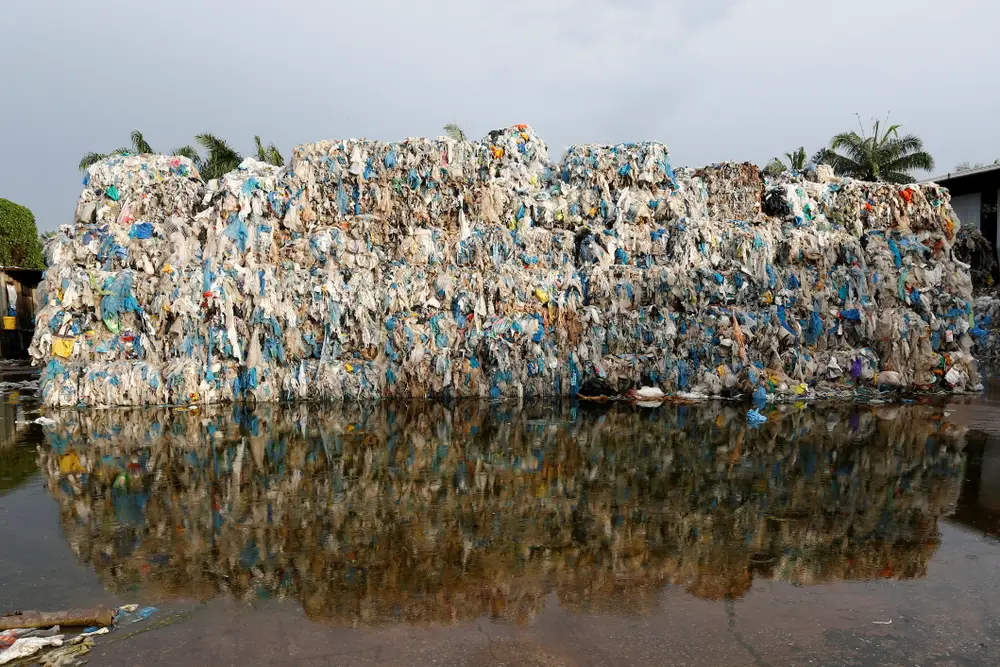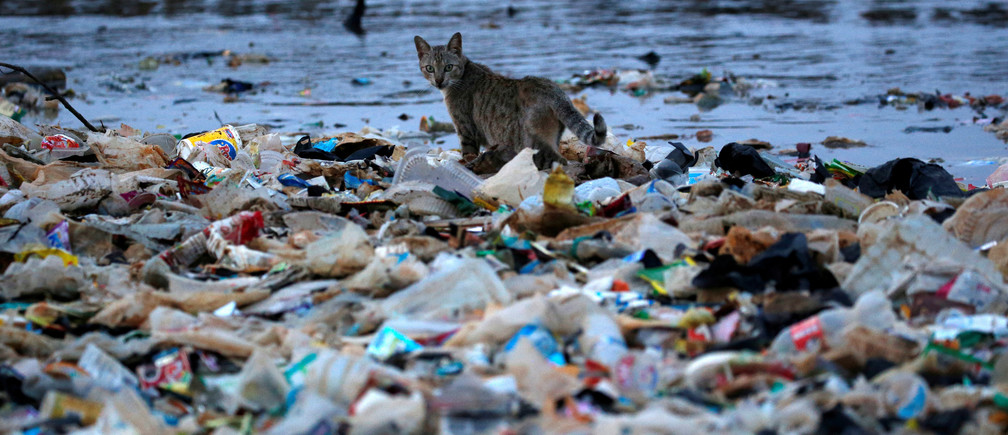Big Oil, Big Plastic: Thank You for Plasticating!
Despite what the oil and petrochemical industries would have us believe, the truth is that plastic isn’t recyclable in practice.
Plastics will represent the largest area of growth for oil demand in the next decades, according to the International Energy Agency. Each year, carbon emissions from producing plastic generate air pollution equivalent to that from 116 coal-fired power plants.
The world is already spilling over with plastic waste. The Great Pacific Garbage Patch (aka the Pacific Trash Vortex) is a vast collection of discarded plastic debris in the North Pacific Ocean. Globally, there are five large systems of circular ocean currents called gyres that are formed by global wind patterns and forces created by Earth’s rotation. Each gyre bears an expanse of non-degradable plastic refuse. Furthermore, estimates say that 4 to 23 times <a third of all plastic produced ends up in our soil and fresh water.
It is far past time to drastically reduce our use of “disposable” plastic and encourage structural, systematic change. We should question the use of plastic in all cases and only accept plastic when absolutely necessary. We can build a sustainable plastic use model (“Say NO to plastic!”) for future generations.

California has passed what we hope will be a model law for the nation (SB 54), phasing out single-use plastics and regulating packaging. Germany’s VerpackG packaging law may be even better: taxing companies for the recycling cost that the packaging will ultimately incur, and using the revenues to fund the recycling system. This gives the companies an incentive to innovate their packaging and shifts the responsibility away from the consumer, where it never should have been.
Plastic harms our environment and health
The harms of plastic go well beyond carbon emissions. Plastics don’t break down into harmless chemicals, but into microplastics. Microplastics are usually defined as pieces of plastic less than 5 millimeters in each dimension.
Microplastics have been found virtually everywhere on Earth: from remote islands to the Mariana Trench; from wastewater treatment plants to remote mountain ranges; from table salt to the soil; in the meat, milk, and blood of farm animals; in bottled water and even tap water. Viruses have been shown to survive by attaching themselves to microplastics. Plastic pellets called “nurdles” have been shown to harbor bacteria like E.coli. As bad as birds trapped in six-pack holders and seals snared in discarded plastic fishing nets are, microplastics are worse, insidiously working their way into every part of our environment.
Plastic is affecting our health as well, far beyond hosting viruses. Polyethylene terephthalate (PET or PETE, RIC #1) is a common material for drink bottles. It and other chemicals in the phthalate family have been linked to a host of health issues, including obesity, early puberty onset, hormonal problems, allergies, breast and liver cancer.
Bisphenol A (BPA) is an additive to many plastics, such as epoxy resins, vinyl ester resins, and polyvinyl chloride (PVC, RIC #3). BPA’s health concerns stem from the fact that it mimics the effects of the hormone estrogen in the human body. BPA substitutes are often used so that products can be labeled “BPA free”, but many studies have indicated they are almost as bad or worse. PVC with added BPA is commonly used as a lining in aluminum cans.
RIC Codes
Resin Identification Codes were introduced in 1988 by the Plastics Industry Association to help workers sort plastics for recycling more easily. (They also provided a convenient advertisement that the industry wanted an environmentally sensitive appearance.) RIC codes weren’t intended for consumers (or businesses), but it’s possible to find some useful information from them.
A rule of thumb for checking plastics that can be unhealthy is to note this RIC number, shown in a triangle of chasing arrows; the “least bad” RIC numbers for human health are RIC #2 (high-density polyethylene), RIC #4 (low-density polyethylene), and RIC #5 (polypropylene).
Plastic isn’t really recyclable
About 9% of plastic made worldwide since 1950 has been recycled. 9.5% was the high mark for plastic recycling in the US, in 2014. At that time, though, China imported millions of tons of US plastic refuse, which the US (falsely) categorized as recycled. In 2017, China stopped accepting most imports of plastic waste. Since then, the US rate of plastic recycling has hovered around 5% to 6%.
The plastic recycling rate is low for several reasons. First, there are many different types of plastic, and each must be sorted so it can be processed with the same type, as determined by its Resin Identification Code.
Second, unlike glass and aluminum, plastics are not only flammable, but also chemically absorbent. For example, plastic that is used to contain weed killer can’t safely be recycled into a takeout food container.
And third, plastic recycling isn’t economical, because the costs of sorting and reprocessing have overtaken the cost of simply producing virgin plastic from oil.
Throughout the world, but especially in the United States, the petrochemical and oil industries have worked to ensure the onus of responsibility for plastic stays on consumers rather than the companies that produce or use plastics.
The failures of advanced recycling
In 2021, an investigative report by Reuters detailed the failures of the company Renewlogy (a joint venture by Dow Inc. and Reynolds Consumer Products) to handle the municipal recycling of Boise, Idaho using chemical recycling, or so-called “advanced recycling”. Residents were assured that their collected recycling could include thin plastic bags and films as well as soiled takeout containers.
Renewlogy planned to heat mixed plastics together at high temperatures in an oxygen-free atmosphere (generally known as pyrolysis) to convert them to diesel fuel. The plan failed within a year, and Renewlogy no longer handles Boise’s recycling.
The company asserted that the problem wasn’t mixing different types of plastic. Instead, it said that the city had claimed a contamination rate that was ten times lower than actuality. As usual, the industry tried to blame the consumer for not giving them what they want, exactly how they want it.
Technological efforts at alleviating the plastic problem
There are always innovative ideas from technology: the British company Notpla has developed edible (and compostable) packaging for water, ketchup, and mayonnaise, but this is a long way from replacing all single-use plastic.
Mango Materials is a Bay Area company that makes a promising biodegradable polyester.
And advanced recycling isn’t completely dead; for example, the French company Carbios has developed a promising enzymatic recycling process for PET that uses depolymerization (converts polymer chains into monomers that can then be reused to synthesize new plastic).
Nevertheless, we have yet to see how economical these technologies will be, and technological innovations don’t solve sorting, flammability, chemical absorbency, or health issues.
Saying NO to Plastic
Four steps to saying NO to single-use plastic: Reuse, Repurpose, Recycle when possible, Eliminate.
- Reuse: reuse plastic items like single-use cutlery as many times as you can
- Repurpose: find other ways to reuse plastic items
- Recycle: stay up to date on how your recycling company can recycle plastic as much as you can, and take advantage of what they can do
- Eliminate: eliminate plastic from your life wherever you can. Great example: SSV Partner Tru Earth produces plastic-free laundry soap and toilet-cleaning disolving tabs. No added water. No big plastic bottles.
As responsible global citizens, we must continue to reduce our use of plastics that are harmful to our health and environment and exert our influence to insist on reusable dishware, eliminate plastic packaging, and question whether we need new uses for plastic. There is hope for making a world that is no longer overflowing with plastic.

Sidebar: Composting
By composting your green waste and food waste, you are helping provide nutrients to the soil, helping save on fertilizer, helping reduce landfills, feeding beneficial microorganisms, helping filter water sources, helping control erosion, and actually sequestering carbon.
It’s not difficult to begin composting at home. It can be broken down into a few simple steps: selecting and storing both wet and dry food scraps and other compostable waste, choosing a suitable place (which could be a shared community garden), layering the wet and dry appropriately to make a compost mix, and finally waiting and aerating.
The company Notpla, mentioned in the main story, means “not plastic”, but also “not PLA”, or polylactic acid. It is plastic made from corn, and hence technically compostable. (Notpla uses algae instead). But if consumer-used PLA cutlery isn’t sent back to an industrial processing facility to be composted, it doesn’t degrade on its own, thus making it similar to most conventional plastic. Thus, this “compostable” cutlery isn’t a huge improvement on typical plastic: you still can’t put it in your compost mix and wait for it to decay.
Links:
11 Easy Ways to Reduce Your Plastic Waste Today
TruEarth Laundry & Toilet Cleaner products
Stasher Silicone Bags
3 Reasons Plastics Won’t Save the Oil Industry
Big Oil’s hopes are pinned on plastics. It won’t end well
The Plastics Pipeline: A Surge of New Production Is on the Way
How Big Oil Misled The Public Into Believing Plastic Would Be Recycled
How Big Oil and Big Soda kept a global environmental calamity a secret for decades
Composting can help fight climate change. Get started in 5 easy steps
